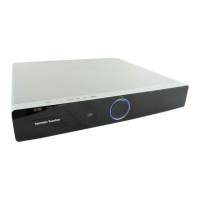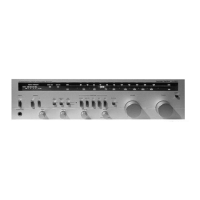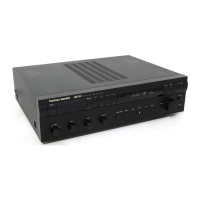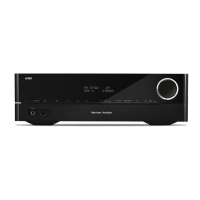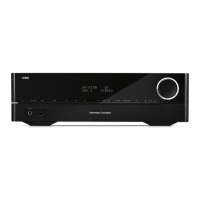TUNING
METERS
Your Receiver
incorporates
two D'Arsonval movement tuning meters for
precise
and
accurate
tuning.
The
FM
tuning meter
is
designed
to
operate
on a
null
or
"zero"
center
principle. Therefore,
the
meter
pointer
should
always
be
at
the
dead
center
position
of
your
meter
dial
for optimum listening
performance.
To
accomplish
this,
rotate
your tuning knob slowly,
in
one
direction
towards
the
station
of
your choice.
As
you tune through
the
station you will notice
the
pointer
swinging
from
the
left
or
right
past
the
zero
center.
THE
CORRECT
POINT for minimum
distortion
and
optimum
FM
reception
is
when
the
pointer
is
resting
at
the
"zero"
center
position.
The
signal
strength meter shows the level
of
the incoming signal.
When
used
in
the
FM
position you should
operate
in
conjunction with
the
FM
tuning
meter
and
tune for maximum indication on
the
signal strength meter
as
well
as
a
"zero"
null on
the
tuning meter.
When
used
in
the
AM
position you simply tune for maximum indication.
STEREO
INDICATOR
A
stereo
indicator
is
located
adiacent
to
the
FM
tuning meter
and
operates
in
coniunction with
the
STEREO
FM
position
of
the
Function switch. The indica-
tor visually shows
the
reproduction
of
FM
stereo
through your receiver.
To
tune for
FM
stereo
proceed
as
follows:
1. Place tile function selector switch
in
the
STEREO
FM
position.
2. Tune to
the
station
of
your choice using your quieting meter for precise
and
accurate
tuning. Your
stereo
indicator
will
now
show
if
you
are
tuned
to a
stereo
program.
If
the
indicator
is
off,
the
program
you
are
listening to
is
being
broadcast
monophonically.
DIAL
SCALE
The dial
scale
on your receiver
is
marked
with
three
scales, namely,
an
FM
frequency
scale
(88-108
MHz), a logging
scale
(0-1 0),
and
an
AM
frequency
scale.
Since most
FM
stations
operate
at
frequencies
which
are
not
whole num-
bers
(such
as
96
MHz
as
compared
to
96.3
MHz), ideally,
each
megahertz
division
on
the
frequency
scale
should
be
divided
into
10
parts
to
enable
the
user to
pinpoint
the
location
of
the
station. This would
require
a
dial
scale
which would
be
longer
than
the
front
panel.
9
The
logging
scale
which
is
divided
into
100
equal
parts
provides a
means
of
finding your favorite station,
once
you
have
noted
its position
on
the
logging
scale.
For
example,
in
New
York City, WQXR
operates
at
96.3
MHz. After
locating this station through
the
use
of
the
frequency
scale
(between
96
and
98
MHz), you find
that
the
pointer
may fall
on
4.2
on
the
logging
scale.
Make
a
note
of
this setting. For future tuning to WQXR simply
set
the
pointer
to
4.2
on
the
logging
scale.
EQUALIZATION
In
order
to
achieve
good
reproduction
of
the
wide
range
of
frequencies
in
music
and
to
make
necessary
adjustment
for
the
limitations
of
the
recording
technique,
record
manufacturers
have
found it
necessary
to modify
the
actual
frequency
response
of
the
music while
it
is
being
recorded.
Thus, to
avoid
overcutting
and
consequent
distortion, a
measured
and
deliberate
reduction
is
effected
in
low
frequency
response
by
selecting a
"turnover
frequency"
and
recording
attenuated
response
below
that
point.
To
assure
optimum signal
to
noise
at
the
high
frequency
end
when
the
record
is
played
at
home, the highs
are
deliberately
exaggerated
during
the
recording
process. A
measured
and
deliberate
boost
is
affected
above
a certain frequency.
This
combination
of
deliberate
exaggeration
at
the
low
and
high
ends
of
the
frequency
spectrum
can
be
expressed
in
a
recording
curve.
When
the
record
is
played
a mirror
image
of
that
curve should
be
available
so
that
the
ideal
"flat"
response
may
be
achieved.
The PHONO 1
/PHONO
2 positions
of
the
function switch automatically in-
troduces
the
proper
equalization.
HUM AND
NOISE
In
any
high fidelity installation, hum may
be
caused
by
the
interconnection
of
a
record
player,
tuner
and
amplifier,
as
a result
of
the
cables
and
different
grounds.
If
hum
is
experienced
with your receiver,
disconnect
everything but
the
speakers
from
the
receiver.
If
hum
persists, reverse the
AC
line
cord.
Plug
in
the
record
player
and
if hum
appears,
reverse
the
record
player
power
plug
and
connect
a single
lead
from
the
record
player
chassis to
the
ground
post
on
the
rear
of
the
receiver chassis.
Connect
your
other
devices
in
this
manner.
CAUTION:
Hum
may
also
be
induced
by
defective
connecting
cables
or
by
running
these
cables
too
close to a strong
AC
field.
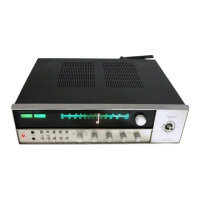
